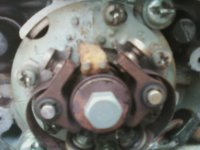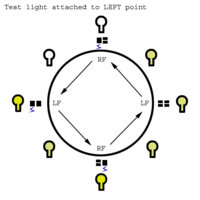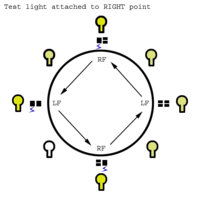I just poured a little gas directly into the bore and it fired; revved a bit on start and backfired out the right side and then stopped firing after it burned off. I am going to get this oil out of the bike and change it when I get home.
-
Enjoy XS400.com? Consider making a donation to help support the site.
XS400.com receives a small share of sales from some links on this page, but direct donations have a much greater impact on keeping this site going.
You are using an out of date browser. It may not display this or other websites correctly.
You should upgrade or use an alternative browser.
You should upgrade or use an alternative browser.
ahale2772
XS400 Addict
sounds like carbs to me, best bet would be to give them a full cleaning, running the bike extensivly with out that cylinder is not going to do you good.
I have a compression testing kit. Since I don't have an electric start can I just kick the bike so the engine turns over? It doesn't even need to be on, correct?
If the problem is at idle then the pilot jet and its passages would be suspect? I took the pilot jet out and it is definitely clear. I sprayed carb cleaner into the passage as well and blew it out with compressed air; all the cleaner flew out the front hole on the air filter side. The float bowl is also getting fuel as I have opened the drain to check.
The reason I suspect the oil is to blame is because I did something silly; The bike was really low on oil (I couldn't get a reading on the dipstick at all) and all I had on hand was 5w30 synthetic. Since 20w50 is the normal weight I surmised the much lighter weight 5w30 could easily sneak past the piston rings into the combustion chamber. The spark plugs do show oil on them and I don't recall seeing any before. I was impatient and I figured wrong oil is better than no or very low oil. Hopefully letting it drain for 24 hours or so should clear most of it out. Is there a good way to get rid of excess oil in the combustion chamber?
If the problem is at idle then the pilot jet and its passages would be suspect? I took the pilot jet out and it is definitely clear. I sprayed carb cleaner into the passage as well and blew it out with compressed air; all the cleaner flew out the front hole on the air filter side. The float bowl is also getting fuel as I have opened the drain to check.
The reason I suspect the oil is to blame is because I did something silly; The bike was really low on oil (I couldn't get a reading on the dipstick at all) and all I had on hand was 5w30 synthetic. Since 20w50 is the normal weight I surmised the much lighter weight 5w30 could easily sneak past the piston rings into the combustion chamber. The spark plugs do show oil on them and I don't recall seeing any before. I was impatient and I figured wrong oil is better than no or very low oil. Hopefully letting it drain for 24 hours or so should clear most of it out. Is there a good way to get rid of excess oil in the combustion chamber?
Ok, so I did a compression test, but I want to make sure I did it correctly. Since I only have a kick start I hooked up the test gauge and simply kicked the bike over few times with everything turned off; each time I turned the engine over the pressure would go up by something like 30 psi; I stopped when I hit 150 psi. Both cylinders were able to hit 150 psi.
I pulled the plugs and drained the oil. After the oil stopped actively dripping out I poured a decent amount of gas into each combustion chamber through the spark plug hole and watched it start dripping out of the oil drain after a few seconds. I am going to let everything drain over night before adding the new oil. I am not sure what else I could do to flush out the 5w30 other than letting everything gravity drain for a long time.
I pulled the plugs and drained the oil. After the oil stopped actively dripping out I poured a decent amount of gas into each combustion chamber through the spark plug hole and watched it start dripping out of the oil drain after a few seconds. I am going to let everything drain over night before adding the new oil. I am not sure what else I could do to flush out the 5w30 other than letting everything gravity drain for a long time.
new kid on the brat
new kid on the brat
i am new to this post having just found this site so i hate to speak out as a newbie..BUT!! KABOOMMM!! bad idea filling your crankcase and trans with explosives!! i have heard of blowing oil pans off of a v8 engine before!! hope things don't get damaged!! i would definetly blow some compressed air through the case until the fumes dissapate
mcrowell75
XS400 Enthusiast
Have you checked your timing? I read your posts and didnt see you mention it. Forgive me if I missed it.
Yes you have confirmed spark and good compression, but is it sparking at the correct micro-second to ignite the gasoline?
Yes you have confirmed spark and good compression, but is it sparking at the correct micro-second to ignite the gasoline?
new kid on the brat
new kid on the brat
does that bike have cdi or points? it did run on a prime though so timing not what i would check first.
I am not worried about it blowing up; I am letting it drain/vent for a good 24+ hours before it gets started again.
Can timing be off on just one side? I figured if the timing was off it would affect both sides. I am more worried about removing the side covers to check because the gaskets are so old. Does this bike use a belt, chain, or just two sprockets touching each other directly? Chains and sprockets don't tend to go bad unless someone set them wrong and the bike only have 10 grand on the odometer. Still, the oil is out right now and I suppose it can't hurt to check one more thing off the list.
It looks like the bike has points because my Haynes is talking about them a lot. I really don't know much about this kind of ignition system and should probably read up on it.
Can timing be off on just one side? I figured if the timing was off it would affect both sides. I am more worried about removing the side covers to check because the gaskets are so old. Does this bike use a belt, chain, or just two sprockets touching each other directly? Chains and sprockets don't tend to go bad unless someone set them wrong and the bike only have 10 grand on the odometer. Still, the oil is out right now and I suppose it can't hurt to check one more thing off the list.
It looks like the bike has points because my Haynes is talking about them a lot. I really don't know much about this kind of ignition system and should probably read up on it.
Looking through the manual I am worried about the actual timing being off because every screw shows signs of being previously adjusted; including the actual timing screws. The LH timing screws (fat ones on the back plate) look very close to what is pictured in the manual, but the RH timing screws (smaller ones on back plate) do not look like they are even close to the same position as pictured in the Haynes manual.
I actually probably did this wrong. Back to the drawing board. I need to see how the points work by rotating the engine.
Edit:
I am currently adjusting the timing and it looks like it is pretty far off. This might explain the fair amount of metallic sheen in my oil
I actually probably did this wrong. Back to the drawing board. I need to see how the points work by rotating the engine.
Edit:
I am currently adjusting the timing and it looks like it is pretty far off. This might explain the fair amount of metallic sheen in my oil
Attachments
Last edited:
mcrowell75
XS400 Enthusiast
I think a video on setting the timing is in order. I'm going to make one today. Keep an eye out. I'll start a thread with a you tube link later.
Don't worry man. Setting the timing is something you would have had to do no matter what. You are not wasting your time here.
Be careful with those screws, I know they get stripped really easy.
Don't worry man. Setting the timing is something you would have had to do no matter what. You are not wasting your time here.
Be careful with those screws, I know they get stripped really easy.
Thanks for the tip; I actually had no idea about that. When I took the timing cover off I also released a ton of oil that did not come out of the regular oil drains; I will definitely take it off every time I change my oil from now on.
I made an attempt at setting the timing and I think I was successful. Here is some footage of my feeble explanation if anyone is interested. This wasn't very well thought out, but I think I had a few tips that might make the process easier for anyone following the manual.
I will reassemble everything and try to fire it up tomorrow. It's too cold and late for that tonight.
I made an attempt at setting the timing and I think I was successful. Here is some footage of my feeble explanation if anyone is interested. This wasn't very well thought out, but I think I had a few tips that might make the process easier for anyone following the manual.
I will reassemble everything and try to fire it up tomorrow. It's too cold and late for that tonight.
ahale2772
XS400 Addict
BC, make sure you dont fire the bike right away after you fill it up, if the gasoline flushed everything you could get into a dry start situation which is no good, I vote you fill it then slowly kick it over a bunch to get oil everywhere.
"I am currently adjusting the timing and it looks like it is pretty far off. This might explain the fair amount of metallic sheen in my oil"
...you should not have any damage from the Ignition timing being off
scince you know your compression is ok then you know your valve timing is ok as well, your ignition timing should be the only thing holding you back, I would also do a quick one-over look at your coils, make sure everything is hooked up and has clean connections
"I am currently adjusting the timing and it looks like it is pretty far off. This might explain the fair amount of metallic sheen in my oil"
...you should not have any damage from the Ignition timing being off
scince you know your compression is ok then you know your valve timing is ok as well, your ignition timing should be the only thing holding you back, I would also do a quick one-over look at your coils, make sure everything is hooked up and has clean connections
I definitely did the timing wrong. It wouldn't start at all but if anything did ignite it was at the wrong time. It actually drove the kick starter backwards and fired it the bottom of the stroke (good thing I had some sturdy boots on for the sake of my shin!); I stopped after that happened. Man, I thought I had this right but it looks like I did it backwards or something 
I carefully recorded the events occurring while I rotate the engine with a test light attached to each point.
The blocks represent the points; left and right; in contact and apart.
The arrows represent the order of events even though I was rotating the engine counter-clockwise.
The bulb color represents intensity; bright, dimly lit, or off.
The lightning bolt represents arching seen at the respective point.
I am really worried about the fact that there is indeed arcing occurring at the LEFT point when RF is reached; this is reflected in the diagram.
I am hoping someone can help me figure this out
Edit:
I checked the resistivity of the coils:
Right primary: 4.0
Right secondary: 13,150
Left primary: 4.5
Left secondary: 13,800
42 degrees F, or 5.5 degrees C
These numbers seem way too high for such a cold temperature. I was under the impression resistance should increase as temperature goes up. Therefore my resistance should be quite low compared to the book figures. Conditions in the manual are listed as:
68 degrees F, or 20 degrees C
Primary: 4 +/- 10% (3.6 to 4.4)
Secondary: 9500 +/- 20% (7,600 to 11,400)
Reading up I guess a high resistance in the secondary winding can cause a weak spark and feedback induction. A high primary winding resistance can also cause a weak spark. I may have found the problem...
Also, is there only the one condenser or am I simply not finding a second one?
Edit :
I did more testing and I am quite confident the timing was set very precisely the first time. Here is my method:
I ran both spark plug cables to one side of the bike so I could see them while I turned the engine counter-clockwise. I put a spark plug on each cable and grounded the tips to the block with alligator clips. I felt for the compression stroke with my thumbs (air blown OUT of the respective spark plug hole). The spark plugs are firing at the exact moment they should be (when they hit the RF/LF line). With the spark plugs grounded I was not getting random arching and I also noticed that I only got arching on the wrong point when the engine was being rotated backwards, so these events are no longer meaningful. This should help with diagnosis!
The blocks represent the points; left and right; in contact and apart.
The arrows represent the order of events even though I was rotating the engine counter-clockwise.
The bulb color represents intensity; bright, dimly lit, or off.
The lightning bolt represents arching seen at the respective point.
I am really worried about the fact that there is indeed arcing occurring at the LEFT point when RF is reached; this is reflected in the diagram.
I am hoping someone can help me figure this out

Edit:
I checked the resistivity of the coils:
Right primary: 4.0
Right secondary: 13,150
Left primary: 4.5
Left secondary: 13,800
42 degrees F, or 5.5 degrees C
These numbers seem way too high for such a cold temperature. I was under the impression resistance should increase as temperature goes up. Therefore my resistance should be quite low compared to the book figures. Conditions in the manual are listed as:
68 degrees F, or 20 degrees C
Primary: 4 +/- 10% (3.6 to 4.4)
Secondary: 9500 +/- 20% (7,600 to 11,400)
Reading up I guess a high resistance in the secondary winding can cause a weak spark and feedback induction. A high primary winding resistance can also cause a weak spark. I may have found the problem...
Also, is there only the one condenser or am I simply not finding a second one?
Edit :
I did more testing and I am quite confident the timing was set very precisely the first time. Here is my method:
I ran both spark plug cables to one side of the bike so I could see them while I turned the engine counter-clockwise. I put a spark plug on each cable and grounded the tips to the block with alligator clips. I felt for the compression stroke with my thumbs (air blown OUT of the respective spark plug hole). The spark plugs are firing at the exact moment they should be (when they hit the RF/LF line). With the spark plugs grounded I was not getting random arching and I also noticed that I only got arching on the wrong point when the engine was being rotated backwards, so these events are no longer meaningful. This should help with diagnosis!
Attachments
Last edited:
mcrowell75
XS400 Enthusiast
Did you set your point gap?
with that gauze filter cover, the torque is very low on those 6 - 10mn lots of peeps strip the thread on those.
Similar threads
- Replies
- 1
- Views
- 538



